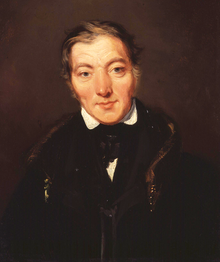Views of -and following- the Welsh manufacturer and socialist Robert Owen (1771-1858).
Human character is shaped by circumstance. It can therefore be transformed by good working conditions, proper housing, and education.
Owen himself attempted to promote this by variously exhorting industrialists, establishing model communities, and encouraging pressure from below through trade unions and co-operatives.
Source:
David Miller et al.Owenismught (Oxford, 1987)
Economic thought

New Harmony, a utopian attempt; depicted as proposed by Robert Owen

Robert Owen
Owen’s economic thought grew out of widespread poverty in Britain in the aftermath of the Napoleonic Wars. His thought was rooted in seventeenth century English “moral economy” ideals of “fair exchange, just price, and the right to charity.” “Utopian socialist” economic thought such as Owen’s was a reaction to the laissez-faire impetus of Malthusian Poor Law reform. Claeys notes that “Owen’s ‘Plan’ began as a grandiose but otherwise not exceptionally unusual workhouse scheme to place the unemployed poor in newly built rural communities.”[2] Owen’s “plan” was itself derivative of (and ultimately popularized by) a number of Irish and English trade unionists such as William Thompson and Thomas Hodgskin, co-founder of the London Mechanics Institute. When this poverty led to revolt, as it did in Glasgow in April 1820, a “committee of gentlemen” from the area commissioned the cotton manufacturer and philanthropist, Robert Owen, to produce a “Report to the County of Lanark” in May 1820, which recommended a new form of pauper relief; the cooperative village. Owen’s villages thus needed to be compared with the Dickensian “Houses of Industry” that were created after the passage of the 1834 Poor Law amendment act. Owen’s report was to spark a widespread “socialist” movement that established co-operatives, labour exchanges, and experimental communities in the United Kingdom, the United States, and Canada.[3] Owen was to disseminate his ideas in North America beginning in 1824. His ideas were most widely received in New York and Philadelphia, where he was greeted by nascent working men’s parties.
Owen was no theoretician, and the Owenite movement drew on a broad range of thinkers such as William Thompson, John Gray, Abram Combe, Robert Dale Owen, George Mudie, John Francis Bray, Dr William King, and Josiah Warren. These men rooted their thought in Ricardian socialism and the labour theory of value.[4]
Utopian communities
United Kingdom
- George Mudie, a printer, formed an Owenite community at Spa Fields, in the London Borough of Islington between 1821 and 1824. Mudie published a weekly journal, the Economist, which ran from 27 January 1821 to 9 March 1822. The printer Henry Hetherington was a member. Mudie moved to Orbiston after this community failed.[5]
- Archibald James Hamilton, the radical laird of Dalzell and Orbiston, owned an estate 8 miles outside Glasgow. He was one of the gentlemen who commissioned Robert Owens’ “Report to the County of Lanark”. In 1821, he and several other Owenite sympathizers such as Abram Combe formed the Edinburgh Practical Society that operated a co-operative store, and a school. In addition, Hamilton provided his 290-acre estate, Orbiston, for the first Owenite co-operative community in the United Kingdom, in 1825. The community collapsed in 1827 on the death of its founder.
- Ralahine Community, County Clare, Ireland (1831–1833) was organized on the estate of John Vandeleur by Edward T. Craig. Unlike other Owenite communities, workers were paid “labour notes” which they could spend in the co-operative store. By this time, Owenism had moved on to its Labour Exchange phase. The experiment ended when Vandeleur lost his estate through gambling.
- Harmony Hall Community at Queenwood Farm, Hampshire (1839–1845). This is the only other colony than New Harmony in Indiana founded by Robert Owen himself. In 1839 his Association of Classes of All Nations acquired five hundred acres at Queenwood farm.[6][7][8]
United States of America
- New Harmony, Indiana (1825–27). Founded by Robert Owen himself. He purchased the community of New Harmony from the religious communists known as the Rappites. The influential Owenite newspaper, “The Free Enquirer” was published here.
- Yellow Springs, Ohio on a site now occupied by Antioch College, Miami Township, Greene County (1825).
- Nashoba Commune, Tennessee (1825–28) was organized by Fanny Wright to educate and emancipate slaves. To ensure emancipation without financial loss to slaveholders, slaves would buy their freedom and then be transported to the independent settlements of Liberia and Haiti.
- Franklin or Haverstraw Community, Haverstraw, Rockland County, New York (1826).
- Forestville Commonwealth, Lapham’s Mills, Coxsackie, Greene County, New York (1826–1827). Also known as the “Coxsackie Community.” Founded by Dr. Samuel Underhill, under the influence of Dr Cornelius Blatchly’s “An Essay on Common Wealths” (1822). Saddled with debt, 27 members decided to join the Kendal community, leaving on 23 Oct. 1827.[9]
- Kendal Community, Ohio, Massillon, Ohio (1825–9). Also known as “Friendly Association of Mutual Interests at Kendal.”[9]
- Valley Forge Community, Valley Forge, Chester County, PA (1826). Also known as “Friendly Association of Mutual Interests.”
- Blue Spring Community, Van Buren Township, Monroe County, Indiana (1826)
- Promisewell Community, Munroe County, PA (1843). Also known as the Society of One-Mentians.
- Goose Pond Community, Pike County, PA (1843). An offshoot of Promisewell, built on the site of Fourierist phalanx “Social Reform Unity.”
- Hunt’s Colony, Spring Lake, Mukwonago Township, Waukesha County, Wisconsin (1843). Also known as the Colony of Equality. Founded by several English organizations

Thank you for every other informative site. Where else may I am getting that kind of info written in such an ideal method? I’ve a project that I’m simply now running on, and I’ve been at the look out for such information.
Wow! This blog looks just like my old one! It’s on a entirely different subject but it has pretty much the same page layout and design. Excellent choice of colors!
Really appreciate you sharing this blog post.Thanks Again. Will read on…
Top ,.. top top … post! Keep the good work on !